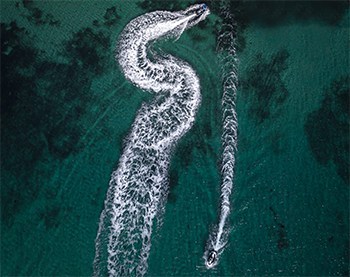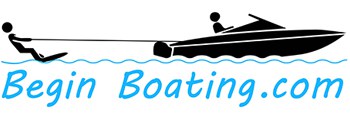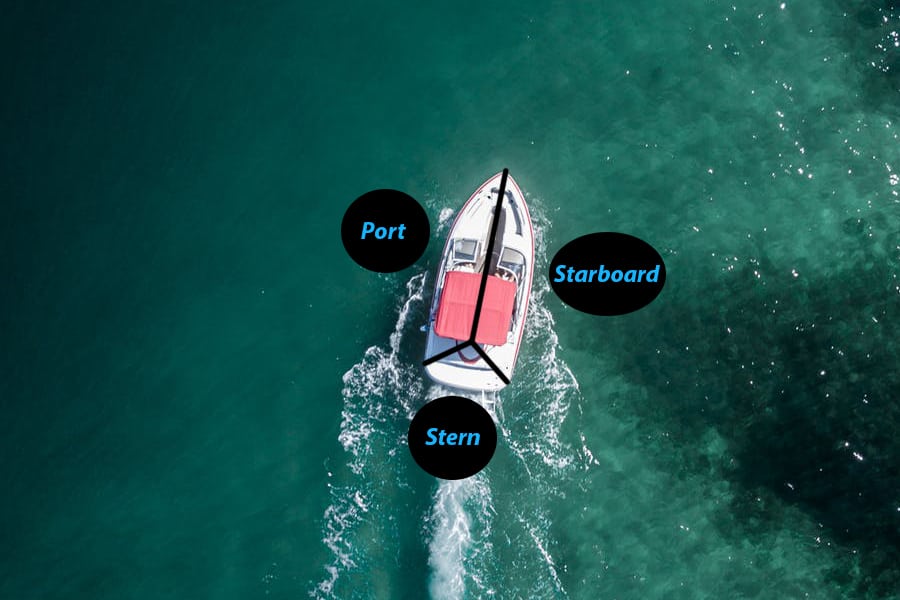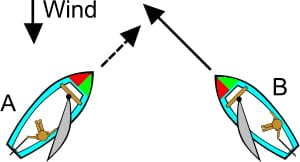To stay as safe out on the water, you must know who has the right of way when meeting another boat. Even if you know whether it is the port or starboard vessel, you don’t know if they know? Many people go boating without a license and without boating knowledge, so you have to ultra-aware to stay safe.
A very generalized rule of thumb for power boating navigation right of way, is that it’s similar to road driving in the United States.
- Approaching another boat head on, you must pass port to port (keep the approaching vessel on your left).
- Crossing paths with another boat, the starboard boat has the right of way (Just like if both vehicles reached an intersection at the same time. The car to the right has right of way).
These are certainly not the only rules for boating navigation, but if you know this much, you are ahead of most people out doing powered pleasure boating. It’s scary to think that if you are accepting and giving right of way correctly, there is still strong potential for collision.
Why Port And Starboard Vs Left And Right
Knowing which side is port and which side is starboard is confusing to most boaters, so they just call it left or right. I kind of agree that it almost seems snobbish to use the nautical term when you know everyone already recognizes Left and Right.

An easy way to remember which side is which, is to just remember that “Port” and “Left” both have four letters. So obviously Starboard will be the other side of the boat.
It’s almost like, back when people were talking on CB radios. There was this secret language of goofy terms for communicating what they wanted to say. It was like a secret club that only members knew what they were saying. They could have just spoke like normal people, but that just would make too much sense. LOL
So to better understand why and who started this way of naming the sides of a boat in nautical terms, I did a little research. The way I understand it, the left and right was just too confusing, because it wasn’t established that you had to be in the craft and facing forward to determine left or right.
So what they did was label each side of the boat as port and starboard, so that no matter what way you are facing, port and starboard are fixed locations on the vessel rather than a direction. I am going to try my best to explain what I found out about the evolution of these nautical terms.
Back when ships didn’t have a fixed rudder in the center of the stern, the sailors would use an oar of sorts held over the stern of the vessel. Since most sailors were right handed, the oar was placed more on the starboard (right) side of the stern (rear) of the boat.
They started referring to that side as being the steering side of the boat, and over time gravitated into calling it starboard. Starboard is derived by combining stéor (meaning “steer”) and bord (meaning “the side of a boat”) from the Old English language.
When docking the vessel, it was easier to dock on the port (left) side because of the steering characteristics of the steering oar location. This docking side became know as “Larboard”. However this was easily confused with Starboard, so they just called it Port side, because that is the side they used to dock in the port and it was the side that the loaders, known as porters used to load good onto the vessel.
While interesting how this all came about, it’s widely known that when determining the left and right sides of a car, boat, plane, or anything else, it’s figured as if you are in it and facing forward. I, still primarily use Left or Right when talking to people about boats. Otherwise I just have to explain Port and Starboard to them.
Giving The Right Of Way To Another Boat
The correct mindset to keep you and your passengers safe, is to assume that the other boats don’t know the rules of boating navigation (and you would actually be correct in most cases).
 It’s always best to boat in large spaces with few boats. Since that can’t always be the case, assume the boat you are approaching has no clue which side to be on when passing each other, it’s up to you to keep steering to the right (starboard) to keep a safe distance between the two boats as you pass each other.
It’s always best to boat in large spaces with few boats. Since that can’t always be the case, assume the boat you are approaching has no clue which side to be on when passing each other, it’s up to you to keep steering to the right (starboard) to keep a safe distance between the two boats as you pass each other.
I’m located near a very large and very busy chain of inland lakes. It’s like navigating through a swarm of bees. There are boats going every direction, so it’s incredibly important to be aware of every boat that is approaching. It’s so busy, it’s almost not fun. WAIT! I’m boating, so of course it’s fun.
Though when you’re entertaining guests in a situation like this, you won’t be interacting with them while you’re underway. You have to stay ultra focused. When you’re in a No Wake zone, at anchor, or docked, you can get back to socializing.
It’s always a good idea to be ready to give way to the other boat, even when you are actually the “stand on boat” (meaning you have the right of way). Assume the approaching boat doesn’t know the rules.
Not only do most pleasure boaters not know the navigational rules of boating, but drinking and driving is also a very common problem. So this ads another level of danger, which causes you to have to stay on super high alert when boating in busy areas.
The Chain O’ Lakes in Illinois is actually patrolled by many sheriff boats. Almost every time I see one, they are tied up to another boat with the red lights on. This is a big revenue generator for the county. I rarely go boating on the Chain because of the dangers, but once in a while we’ll go tour the lakes and eat at a great restaurant on the water.
Because of the lack of rules being followed, the drinking and driving, and the crowded lakes, I would never tow a skier, tuber, etc. on this chain of lakes. There has been kids run over by other boats when tubing. It’s sad but the captain should have never risked towing in such a crowded area. Again, you are the captain and it’s your responsibility to keep everyone safe.
Powered, Non-powered, And Size Matters In Boat Navigation
We are power boaters on this site. The rules are different when the different types of boats cross paths. I’ll give you a few scenarios.
- Whether you are in a powered boat or a sail boat, if you are crossing paths with a large ship such as a barge, container ship, cruise ship, etc., you must give way. For your own good you should give a very wide birth (keep a large distance) to large watercrafts. They don’t have the ability to make quick course changes or speed reductions.
 When two sailboats cross paths, the boat with the wind on the port side must give way to the boat with wind on the starboard side. However, if both sailboats have wind on the same side, the leeward (downwind) boat is the stand on boat, so the windward (upwind) boat must give way.
When two sailboats cross paths, the boat with the wind on the port side must give way to the boat with wind on the starboard side. However, if both sailboats have wind on the same side, the leeward (downwind) boat is the stand on boat, so the windward (upwind) boat must give way.- A powered boat crossing paths with a sailboat, the powered boat must give way. It doesn’t matter if you are starboard or port of the sailboat (under sail power), they are the stand on boat. If they aren’t under sail power and are using their motor to move the boat, then both crafts are considered powered boats and standard rules apply.
 When approaching ANY vessel from the stern (rear), that front vessel has the right of way ALWAYS. You can overtake (pass) them on either side giving plenty of birth. Always assume they don’t know you are approaching and before overtaking them, sound your horn twice to pass starboard or to pass on the port side. If you hear them respond with 5 short horn blasts, then it is unsafe to pass.
When approaching ANY vessel from the stern (rear), that front vessel has the right of way ALWAYS. You can overtake (pass) them on either side giving plenty of birth. Always assume they don’t know you are approaching and before overtaking them, sound your horn twice to pass starboard or to pass on the port side. If you hear them respond with 5 short horn blasts, then it is unsafe to pass.
Once the sun goes down it’s easy to know if you have the right of way or not. When you see an approaching boat, look at their bow navigation light. If you see “red” then the other craft have the right of way. If you see green, then you have the right of way. Red means stop (give way), and green means go (you have the right of way).
If you approach a boat at night and only see the white light, you are approaching the stern of their boat. Steer very clear, and/or sound your horn twice to pass starboard or port side. Remember to listen for a reply from them to determine if it is safe or not. They may or may not respond, but if you hear those 5 short blasts, there is danger.
Stay Safe
If you ever want to dive deeper into the official US Coast Guard navigation rules go to their site here.
The best way to keep you and your boating guest safe is to be better informed. Not just with rules and regulations, but with better understanding of boating terminology as well as mechanical and operational knowledge of your boat.
I would like to suggest that you bookmark BeginBoating.com as well as researching our other articles. Maybe just start with the two suggested articles below. The goal of Begin Boating is to not only get more people into the recreational sport of boating, but to also create better informed boaters, so there is more enjoyment of the sport for everyone.



